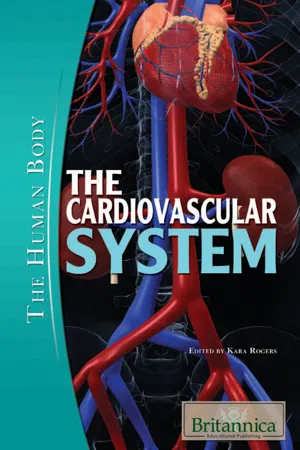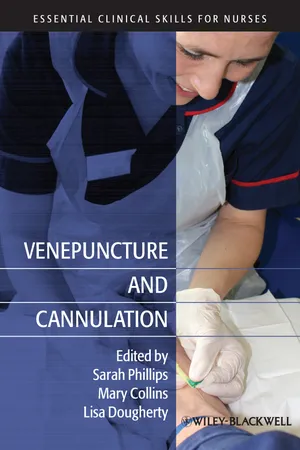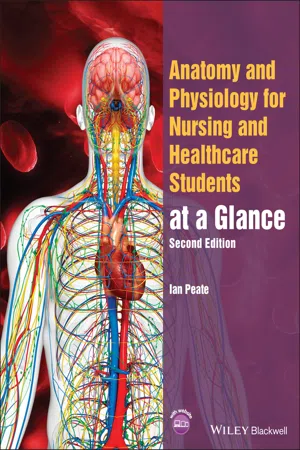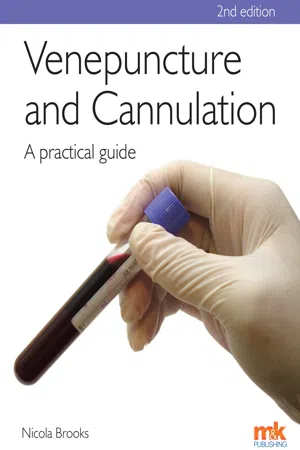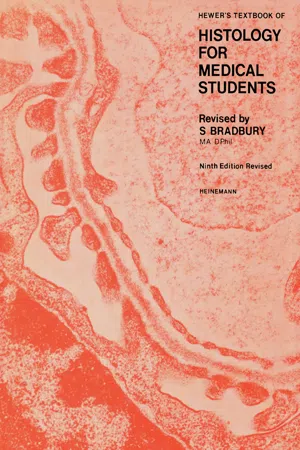Circulatory System
The circulatory system is a network of organs and vessels that transports blood, nutrients, and oxygen throughout the body. It consists of the heart, blood vessels, and blood. The system plays a crucial role in maintaining homeostasis by delivering essential substances to cells and removing waste products.
8 Key excerpts on "Circulatory System"
- eBook - ePub
Fundamentals of Anatomy and Physiology
For Nursing and Healthcare Students
- Ian Peate, Suzanne Evans, Ian Peate, Suzanne Evans(Authors)
- 2020(Publication Date)
- Wiley-Blackwell(Publisher)
...The blood transports many substances, such as red blood cells, white blood cells, hormones and electrolytes essential for cellular function. It also plays a major role in the body’s defence against bacteria and other organisms through the action of the white blood cells. The blood also transports waste products of metabolism; for example, urea, carbon dioxide and uric acid. Blood that is pumped out of the left ventricle of the heart is transported by a network of vessels called arteries and the blood is returned to the heart by the veins. There are three types of blood vessels: arteries, veins and capillaries. Arteries carry blood away from the heart, while the veins transport blood to the heart. The blood vessels of the Circulatory System are a closed system, in that blood does not leave or leak out of the blood vessels unless they are damaged. It is at the capillary end that nutrients and other products essential for cellular function leave the blood vessels. White blood cells may also leave the blood vessels at the capillary end; however, red blood cells are contained within the Circulatory System. The lymphatic system is also known as the secondary circulation. It transports fluid called lymph, which is an ultrafiltrate of the blood. It plays an important part in the immune system...
- Ian Peate, Muralitharan Nair, Ian Peate, Muralitharan Nair(Authors)
- 2011(Publication Date)
- Wiley-Blackwell(Publisher)
...There are three types of blood vessels: arteries, veins and capillaries. Arteries carry blood away from the heart while the veins transport blood to the heart. The blood vessels of the Circulatory System are a closed system in that blood does not leave or leak out of the blood vessels unless they are damaged. It is at the capillary end that nutrients and other products essential for cellular function leave the blood vessels. White blood cells may also leave the blood vessels at the capillary end; however, red blood cells are contained within the Circulatory System. The lymphatic system is also known as the secondary circulation. It transports fluid called lymph which is an ultrafiltrate of the blood. It plays an important part in the immune system...
- eBook - ePub
- Britannica Educational Publishing, Kara Rogers(Authors)
- 2010(Publication Date)
- Britannica Educational Publishing(Publisher)
...The portal system, for example, consists of a network of vessels and is specially designed to transport blood from the abdomen to the liver, where nutrients, wastes, and other substances that have been absorbed from the gastrointestinal tract are metabolized. The processed blood then leaves the liver and travels to the heart. Two other readily distinguished systems are the pulmonary circulation, which is a closed network of vessels that supplies blood only to the heart and lungs, and the systemic circulation, which supplies blood to tissues throughout the body. ARTERIES Arteries are any of the vessels that, with one exception, carry oxygenated blood and nourishment from the heart to the tissues of the body. The exception, the pulmonary artery, carries oxygen-depleted blood to the lungs for oxygenation and removal of excess carbon dioxide. Transverse section of an artery. Encyclopædia Britannica, Inc. Arteries transport blood to body tissues under high pressure, which is exerted by the pumping action of the heart. The heart forces blood into the elastic tubes, which recoil, sending blood on in pulsating waves. The pulse, which can be felt over an artery lying near the surface of the skin, results from the alternate expansion and contraction of the arterial wall as the beating heart forces blood into the arterial system via the aorta. Large arteries branch off from the aorta and in turn give rise to smaller arteries until the level of the smallest arteries, or arterioles, is reached. The threadlike arterioles carry blood to networks of microscopic capillaries, which supply nourishment and oxygen to the tissues and carry away carbon dioxide and other products of metabolism by way of the veins. Because the blood is pushed through the arteries at high pressure, it is imperative that the vessels possess strong, elastic walls. These features also ensure that the blood flows quickly and efficiently to the tissues. The wall of an artery consists of three layers...
- eBook - ePub
- J R Levick(Author)
- 2013(Publication Date)
- Butterworth-Heinemann(Publisher)
...Chapter 1 Overview of the cardiovascular system Publisher Summary This chapter provides an overview of the cardiovascular system. The rate at which diffusional transport occurs is critically important because the supply of nutrients must keep up with cellular demand. The first and foremost function of cardiovascular system is the rapid convection of oxygen, glucose, amino acids, fatty acids, vitamins, drugs, and water to the tissues and the rapid washout of metabolic waste products like carbon dioxide, urea, and creatinine. The cardiac output is the volume of blood ejected by one ventricle during one minute, and this depends on both the volume ejected per contraction (the stroke volume) and the number of contractions per minute (heart rate). The behavior of the heart and the blood vessels has to be regulated to deal with varying environmental and internal stresses. 1.1 Diffusion: its virtues and limitations 1.2 Functions of the cardiovascular system 1.3 Circulation of blood 1.4 Cardiac output and its distribution 1.5 Introducing some hydraulic considerations: pressure and flow 1.6 Structure and functional classification of blood vessels 1.7 Plumbing of the vascular circuits 1.8 Central control of the cardiovascular system The heart and blood vessels form a system for the rapid transport of oxygen, nutrients, waste products and heat around the body. Small primitive organisms lack such a system because their needs can be met by direct diffusion from the environment, and even in man diffusion remains the fundamental transport process between blood and cells. In order to appreciate fully the need for a cardiovascular system we must begin by considering some properties of the diffusion process. 1.1 Diffusion: its virtues and limitations The ‘drunkard’s walk’ theory Diffusion is a passive process in that it is not driven by metabolic energy but arises from the innate random thermal motion of molecules in a solution or gas...
- eBook - ePub
- Sarah Phillips, Mary Collins, Lisa Dougherty, Sarah Phillips, Mary Collins, Lisa Dougherty(Authors)
- 2011(Publication Date)
- Wiley-Blackwell(Publisher)
...3 Anatomy and Physiology Mary Collins LEARNING OUTCOMES The practitioner will be able to: Describe the parts of the Circulatory System. Understand the anatomy and physiology of veins. Identify veins in the arm and hand. Explain the components of blood. INTRODUCTION The Circulatory System consists of a network of blood vessels which transport blood and its components around the body. One type of blood vessel, namely veins, give access to the Circulatory System. Veins do not, however, occur in isolation and therefore to avoid causing damage to arteries and nerves, anatomical knowledge is required to ensure adequate care is taken during the assessment and subsequent accessing of the vein for the procedures of venepuncture or cannulation. OVERVIEW OF THE Circulatory System The Circulatory System consists of the pulmonary and the systemic systems. In relation to venepuncture and cannulation the systemic system, the larger of the two, is the most relevant for venepuncture and cannulation. It consists of the heart, functioning as a pump which requires a transport network that is made up of arteries, veins and capillaries to carry blood and its components to and from the tissues (Herbert & Sheppard 2005; Weinstein 2007). The heart is a muscular pump receiving deoxygenated blood from the body via veins that empty into its right chambers. These chambers are known as the right atrium and right ventricle (Marieb 2006). The blood on leaving the atrium and entering the ventricle is prevented from flowing back into the atrium by a valve (tricuspid). The heart pumps the deoxygenated blood out of the right ventricle, via the pulmonary artery to the lungs, where it receives oxygen and excretes carbon dioxide. The oxygenated blood returns to the left atrium and when the heart contracts the blood is forced into the left ventricle, where again a valve (mitral) prevents any backflow to the left atrium...
- Ian Peate(Author)
- 2022(Publication Date)
- Wiley-Blackwell(Publisher)
...This blood is carried by several different types of blood vessels, each of which is specialised so as to play its role in circulating the blood around the body. The blood vessels Blood vessels are part of the Circulatory System that transports blood throughout the body. There are three major types of blood vessels (Figure 20.1). The arteries, carrying the blood away from the heart. The capillaries, which enable the exchange of water, nutrients and chemicals between the blood and the tissues. The veins, which carry blood from the capillaries back towards the heart. All arteries, with the exception of the pulmonary and umbilical arteries, carry oxygenated blood, while most veins carry deoxygenated blood from the tissues back to the heart, with the exceptions of the pulmonary and umbilical veins, both of which carry oxygenated blood. The capillaries form the microCirculatory System and it is at this point that nutrients, gases, water and electrolytes are exchanged between the blood and the tissue fluid. Capillaries are tiny, extremely thin‐walled vessels that act as a bridge between arteries and veins. The thin walls of the capillaries enable oxygen and nutrients to be passed from the blood into tissue fluid and allow waste products to pass from tissue fluid into the blood. Structure of the blood vessels Generally, the arterial system transports oxygenated blood from the heart and delivers it to the capillaries. In the capillaries, oxygen and nutrient exchange can occur. The walls of the larger blood vessels consist of three layers (Figure 20.2). The tunica intima consists of a thin layer of endothelial cells. The tunica media contains smooth muscles and elastic fibres. The tunica externa is an outer layer consisting of fibroblasts, nerves and collagenous tissue. The endothelium is an epithelial lining that is only one cell thick...
- eBook - ePub
- Nicola Brooks(Author)
- 2017(Publication Date)
- M&K Update(Publisher)
...This helps prevent further injury to the body from fluid loss. 3 Maintenance of homeostasis: This is a process by which the blood helps to control body temperature and the pH (acid and alkali balance) within the body. Blood vessels There are five types of blood vessel: Arteries Arterioles Capillaries Venules Veins. Blood first travels away from the heart via the aorta (an artery). Gradually, as the blood travels through the network of arteries, the arteries become narrower, and eventually they become arterioles. These arterioles enter tissue and continue to branch out and reduce in size as they do so. The arterioles then branch into tiny vessels called capillaries. At this point, the exchange of materials occurs. For example, oxygen will leave the blood and enter the cell, and waste products will leave the cells and enter the blood (Peate & Nair 2011). The blood now begins its journey back to the heart. As the capillaries leave the tissue they become venules. As the vessels continue they increase in size becoming veins. Finally all the veins converge into the vena cava returning the blood to the right side of the heart (Peate & Nair 2011). Understanding the structural differences between an artery and a vein Apart from the functional differences between an artery and a vein discussed above, there are some structural differences that are important in relation to venepuncture and intravenous cannulation. Both arteries and veins consist of three layers of tissue: 1. The outermost layer: the Tunica Externa, which gives support and stability 2. The middle layer: the Tunica Media, which allows for changing blood flow and pressure 3. The innermost layer: the Tunica Intima, which facilitates blood flow. Figure 2.1: The structure of the artery Figure 2.2: The structure of the vein Arteries are designed to carry blood travelling at relatively high pressure (such as 120mmHg)...
- S. Bradbury(Author)
- 2014(Publication Date)
- Butterworth-Heinemann(Publisher)
...CHAPTER 13 THE BLOOD Circulatory System Publisher Summary The system responsible for the circulation of the blood consists of a closed system of tubes of varying caliber; one part of the original tube is specially modified to become the central pump or heart. This chapter provides an overview of the Circulatory System. It presents the three different kinds of arteries: elastic arteries, muscular arteries, and arterioles. The wall of an artery is relatively thick and not affected by changes of external pressure. Contraction of the circular muscle cannot completely occlude the lumen because of the existence of an elastic lamina internal to the muscle. The general structure of the walls of the veins is similar to that of the arteries. The terminal ramifications of the small arterioles are usually connected with the corresponding terminal ramifications of the small venules by a capillary network; the transition is gradual and the density of the network in any organ varies directly with the metabolic activity of that organ. The system responsible for the circulation of the blood consists of a closed system of tubes of varying calibre; one part of the original tube is specially modified to become the central pump or heart. It is important to remember that the whole system—heart, arteries, capillaries, veins—is lined by a flattened endothelium of mesodermal origin, which rests on a varying amount of connective tissue...


